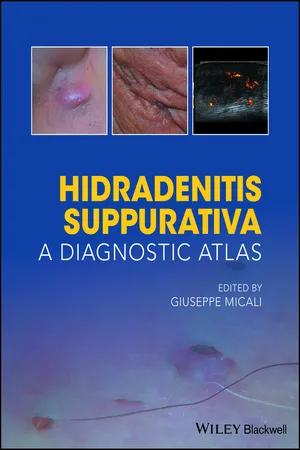
- English
- ePUB (mobile friendly)
- Available on iOS & Android
About this book
Hidradenitis Suppurativa: A Diagnostic Atlas provides a unique visual aid to the diagnosis of Hidradenitis Suppurativa (HS), also known as "acne inversa." The book covers the epidemiology and pathogenesis of the disease, its typical presentation, differences in manifestations of cutaneous versus systemic instances, and considerations for clinical and histopathological differential diagnosis. Guidance is also provided for the classification of disease severity and for managing the impact of HS on the patient's quality of life.
The book is packed with high-quality, full-color clinical images for each of the most common HS diagnostic imaging techniques, such as videodermatoscopy, ultrasound, computed tomography, and magnetic resonance imaging. As a clinical atlas, it helps dermatologists with differential diagnoses and correct assessments of disease severity, as well as possible complications of the condition. The book:
- Is highly focused on acne inversa, which can have a debilitating impact on quality of life
- Includes over 200 outstanding diagnostic clinical images
- Covers all imaging modalities used in the diagnosis and management of Hidradenitis Suppurativa
This book is a key resource for dermatologists, dermatopathologists, and dermatology nurses working with patients with HS.
Frequently asked questions
- Essential is ideal for learners and professionals who enjoy exploring a wide range of subjects. Access the Essential Library with 800,000+ trusted titles and best-sellers across business, personal growth, and the humanities. Includes unlimited reading time and Standard Read Aloud voice.
- Complete: Perfect for advanced learners and researchers needing full, unrestricted access. Unlock 1.4M+ books across hundreds of subjects, including academic and specialized titles. The Complete Plan also includes advanced features like Premium Read Aloud and Research Assistant.
Please note we cannot support devices running on iOS 13 and Android 7 or earlier. Learn more about using the app.
Information
CHAPTER 1
Introduction
References
- Dessinioti C, Katsambas A, Antoniou C. Hidradenitis suppurativa (acne inversa) as a systemic disease. Clin Dermatol 2014; 32: 397–408
- Verneuil A. Etudes sur les tumeurs de la peau; de quelques maladies des glandules sudoripares. Arch Gen Med 1854; 4: 447–468
- Jemec GBE, Revuz J, Leyden JJ (eds). Hidradenitis suppurativa. Springer, Berlin, 2006
- Schuster S. The nature and consequence of Karl Marx's skin disease. Br J Dermatol 2008; 158: 1–3
- Pillsbury DM, Shelley WB, Kligman AM. Bacterial infections of the skin. In Dermatology. Saunders, Philadelphia, 1956
- Plewig G, Kligman AM. Acne, morphogenesis and treatment. Springer, Berlin, 1975
- Chen W, Plewig G. Should hidradenitis suppurativa/acne inversa best be renamed as “dissecting terminal hair folliculitis”? Expl Dermatol 2016 [Epub ahead of print]
- Lipsker D, Severac F, Freysz M, et al. The ABC of hidradenitis suppurativa: a validated glossary on how to name lesions. Dermatology 2016; 232: 137–142
CHAPTER 2
Epidemiology and pathogenesis
2.1 Epidemiology
| Prevalence | 0.00033% to 4.1% (0.7%) pediatric age – before 16 (8%) |
| Incidence | 6 cases out of 100.000 person/year |
| Obesity (BMI ≥ 30 kg/m2) | Odd ratio 6.38 hospital-based HS Odd ratio 2.56 population-base... |
Table of contents
- Cover
- Title page
- Copyright
- List of contributors
- Foreword
- Chapter 1 Introduction
- Chapter 2 Epidemiology and pathogenesis
- Chapter 3 Clinical features and diagnostic clues
- Chapter 4 Histopathology
- Chapter 5 Classification and severity scales
- Chapter 6 Correlation between severity and its impact on quality of life
- Chapter 7 Comorbidities and complex syndromes
- Chapter 8 Complications
- Chapter 9 Ultrasound imaging
- Chapter 10 Radiological imaging
- Chapter 11 Skin imaging: dermatoscopy
- Chapter 12 Differential diagnosis
- Chapter 13 Conclusions
- Index
- EULA